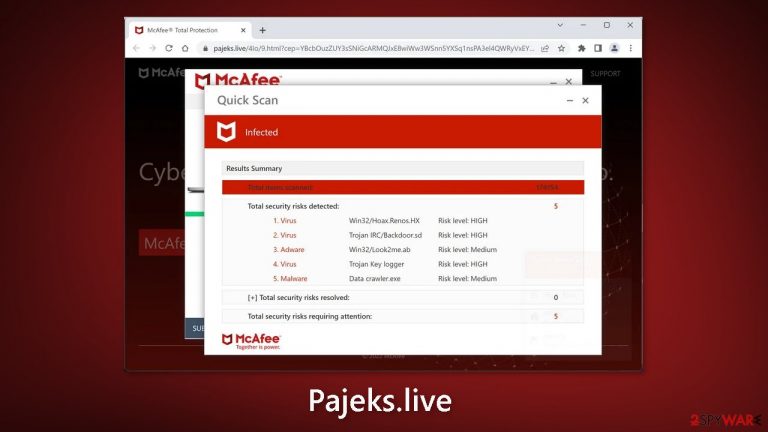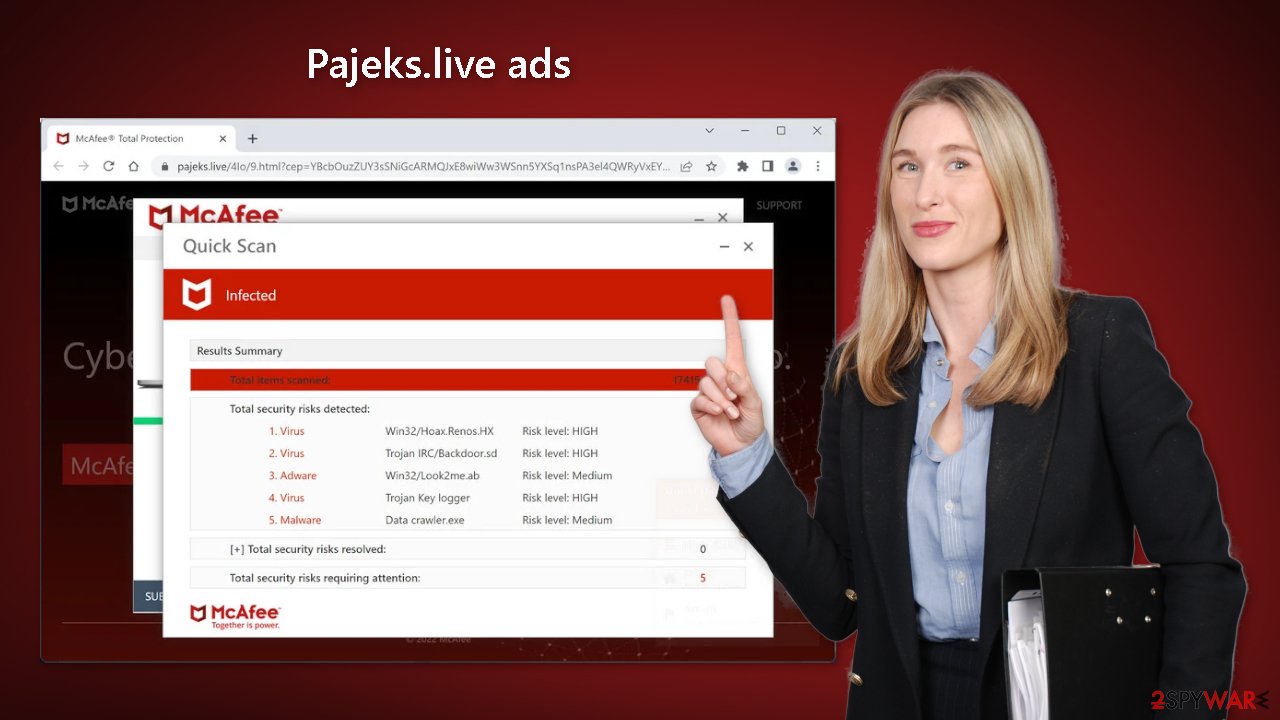Pajeks.live ads (fake) - Free Guide
Pajeks.live ads Removal Guide
What is Pajeks.live ads?
Pajeks.live is a fake security alert made to look like a message from McAfee Antivirus

Pajeks.live is a website set up by fraudsters to generate income. It is designed to look like a McAfee security alert. Users are informed that their McAfee subscription has expired and that their computer has been infected with multiple viruses. McAfee, predictably, has nothing to do with this fraudulent campaign.
Crooks only use their brand and name to gain trust. The site's main goal is to direct users to the official McAfee website and earn money through the affiliate program. The page, however, may result in push notification spam. People have reported seeing pop-ups that say their system is infected after the encounter.
Unfortunately, fraudsters may also use rogue advertising networks[1] to place advertisements that direct users to dangerous websites. Users may be directed to fraudulent websites in an attempt to trick them into providing personal information, downloading PUPs (potentially unwanted programs),[2] or even malware.
| NAME | Pajeks.live |
| TYPE | Push notification spam; adware |
| SYMPTOMS | A page appears seemingly out of nowhere warning users about virus infections; users may start seeing pop-ups that look like security alerts; |
| DISTRIBUTION | Shady websites; deceptive ads; bundled software |
| DANGERS | People may be tricked into providing personal information, downloading potentially unwanted programs, or even malware |
| ELIMINATION | Disable push notifications in the browser settings; run a system scan with professional security tools |
| FURTHER STEPS | Use FortectIntego to fix any remaining damage and optimize the machine |
Distribution methods
Pages like Pajeks.live are rarely found in search results. Users must usually browse through shady, unregulated sites in order to find them. Illegal streaming websites,[3] for example, are riddled with deceptive ads and sneaky redirects. They can also show bogus “Download” and “Play” buttons, which open new tabs.
That is why it is critical to only visit websites that you are familiar with and trust. Do not click on random links or advertisements, even if they appear to promote legitimate products or services. Use legitimate streaming platforms, such as Netflix or Hulu, which charge a small monthly subscription fee.

Adware infections
Another reason you may be seeing the deceptive page is that you have adware. It is advertising-supported software that can cause an increased amount of commercial content, like pop-ups, banners, and redirects. It runs in the background, unnoticed by the users.
It is usually spread via freeware distribution platforms. They include bundled software in the installers but do not clearly disclose it. We recommend that you pay close attention during the installation process:
- Select the “Custom” or “Advanced” installation methods at all times.
- Read the Privacy Statement and the Terms of Service.
- Examine the file list and uncheck any unrelated applications.
How to disable fake alerts?
To stop annoying virus alerts from Pajeks.live, you have to block the site permissions that allow it to show you push notifications. You can do that by following our step-by-step guide:
Google Chrome (desktop):
- Open Google Chrome browser and go to Menu > Settings.
- Scroll down and click on Advanced.
- Locate the Privacy and security section and pick Site Settings > Notifications.

- Look at the Allow section and look for a suspicious URL.
- Click the three vertical dots next to it and pick Block. This should remove unwanted notifications from Google Chrome.

Google Chrome (Android):
- Open Google Chrome and tap on Settings (three vertical dots).
- Select Notifications.
- Scroll down to Sites section.
- Locate the unwanted URL and toggle the button to the left (Off setting).

Mozilla Firefox:
- Open Mozilla Firefox and go to Menu > Options.
- Click on Privacy & Security section.
- Under Permissions, you should be able to see Notifications. Click Settings button next to it.

- In the Settings – Notification Permissions window, click on the drop-down menu by the URL in question.
- Select Block and then click on Save Changes. This should remove unwanted notifications from Mozilla Firefox.

Safari:
- Click on Safari > Preferences…
- Go to Websites tab and, under General, select Notifications.
- Select the web address in question, click the drop-down menu and select Deny.

MS Edge:
- Open Microsoft Edge, and click the Settings and more button (three horizontal dots) at the top-right of the window.
- Select Settings and then go to Advanced.
- Under Website permissions, pick Manage permissions and select the URL in question.
- Toggle the switch to the left to turn notifications off on Microsoft Edge.

MS Edge (Chromium):
- Open Microsoft Edge, and go to Settings.
- Select Site permissions.
- Go to Notifications on the right.
- Under Allow, you will find the unwanted entry.
- Click on More actions and select Block.

Clear the browser from cookies
Cookies are small text files that can track your browsing activity and store information such as your IP address, geolocation, websites visited, links clicked on, and items purchased. This information is normally used to personalize the user experience, but crooks use it to make money. They are marketable to ad networks and other third parties.
They can even be hijacked and used for malicious purposes, which is why security experts advise that they be cleared on a regular basis. A maintenance tool like FortectIntego can make this process much easier. Furthermore, this powerful software can repair a variety of system errors, corrupted files, and registry issues, which is especially useful following a virus infection.
Scan your machine with anti-malware tools
If you disabled push notifications but still experience unwanted symptoms such as unexpected redirects and an increase in commercial content such as pop-ups and banners, you should run an adware scan on your system. For PUP removal, we recommend using trusted professional security tools SpyHunter 5Combo Cleaner or Malwarebytes. Most suspicious apps should be detected and removed successfully.
Of course, you can manually remove a PUP, but it is unknown which specific app is causing annoying behavior because crooks disguise them as “useful” tools. Manual uninstallation may also leave some traces of the program behind, which may result in the infection reappearing.
However, if you still do not want to use security tools and know which program is at fault, use the instructions below to help you uninstall it:
Windows 10/8:
- Enter Control Panel into Windows search box and hit Enter or click on the search result.
- Under Programs, select Uninstall a program.

- From the list, find the entry of the suspicious program.
- Right-click on the application and select Uninstall.
- If User Account Control shows up, click Yes.
- Wait till uninstallation process is complete and click OK.

Windows 7/XP:
- Click on Windows Start > Control Panel located on the right pane (if you are Windows XP user, click on Add/Remove Programs).
- In Control Panel, select Programs > Uninstall a program.

- Pick the unwanted application by clicking on it once.
- At the top, click Uninstall/Change.
- In the confirmation prompt, pick Yes.
- Click OK once the removal process is finished.
Mac:
- From the menu bar, select Go > Applications.
- In the Applications folder, look for all related entries.
- Click on the app and drag it to Trash (or right-click and pick Move to Trash)

To fully remove an unwanted app, you need to access Application Support, LaunchAgents, and LaunchDaemons folders and delete relevant files:
- Select Go > Go to Folder.
- Enter /Library/Application Support and click Go or press Enter.
- In the Application Support folder, look for any dubious entries and then delete them.
- Now enter /Library/LaunchAgents and /Library/LaunchDaemons folders the same way and terminate all the related .plist files.

How to prevent from getting adware
Do not let government spy on you
The government has many issues in regards to tracking users' data and spying on citizens, so you should take this into consideration and learn more about shady information gathering practices. Avoid any unwanted government tracking or spying by going totally anonymous on the internet.
You can choose a different location when you go online and access any material you want without particular content restrictions. You can easily enjoy internet connection without any risks of being hacked by using Private Internet Access VPN.
Control the information that can be accessed by government any other unwanted party and surf online without being spied on. Even if you are not involved in illegal activities or trust your selection of services, platforms, be suspicious for your own security and take precautionary measures by using the VPN service.
Backup files for the later use, in case of the malware attack
Computer users can suffer from data losses due to cyber infections or their own faulty doings. Ransomware can encrypt and hold files hostage, while unforeseen power cuts might cause a loss of important documents. If you have proper up-to-date backups, you can easily recover after such an incident and get back to work. It is also equally important to update backups on a regular basis so that the newest information remains intact – you can set this process to be performed automatically.
When you have the previous version of every important document or project you can avoid frustration and breakdowns. It comes in handy when malware strikes out of nowhere. Use Data Recovery Pro for the data restoration process.
- ^ Zeljka Zorz. How does a rogue ad network function?. Helpnetsecurity. Information Security Blog.
- ^ Wendy Zamora. What is a PUP? – How to avoid potentially unwanted programs. Malwarebytes. Tips, Tricks, and How-Tos.
- ^ Brittni Devlin. Why Should You Avoid Illegal Streaming Sites?. Makeuseof. Security Blog.
